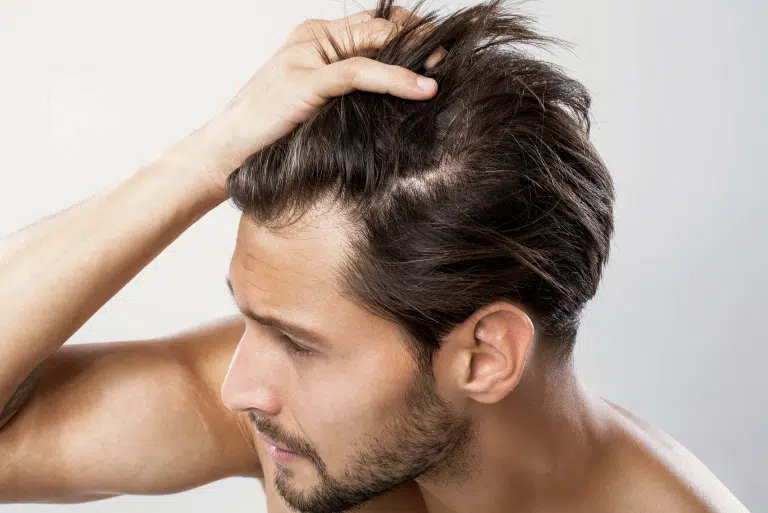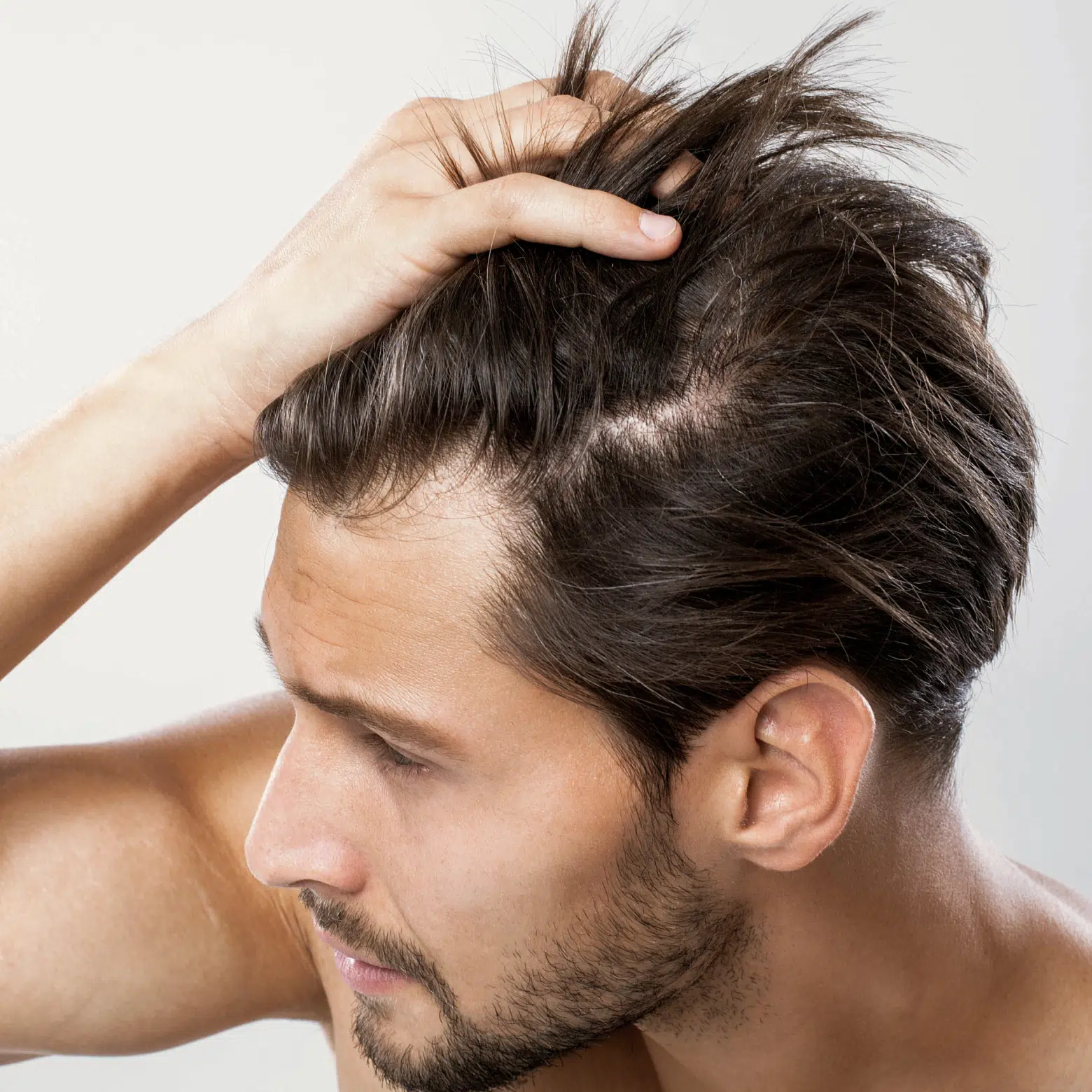Hair transplant
Hair transplantation is a durable and effective solution for correcting hair loss. At our Leman Aesthetic Clinic centers, we use the most advanced techniques to deliver natural results with no visible scars. Whether it’s to increase the density of balding areas or treat established baldness, our procedures help restore confidence and self-esteem.


What causes hair loss?
Hair loss is a natural part of the hair cycle. We speak of baldness or alopecia when hair loss accelerates without regrowth. Many factors contribute to hair loss. These include aging, genetic predisposition, hormonal imbalances, stress, poor diet and certain medical treatments. Although more common in men, hair loss can also affect women.
When should a hair transplant be performed?
Once hair density has been lost, the only definitive and satisfactory treatment is a hair transplant. This involves transplanting hair that is “resistant” to the hair loss process to balding areas, be they the forehead, gulfs, vertex or tonsure.
Depending on the type and severity of alopecia, we choose the most appropriate technique.
At our center, we use the very latest aesthetic medicine technologies, making it possible to perform hair micrografting without the inconvenience of a scar (FUE technique).
Hair loss, which is much more common in men than in women, can also be a concern. The techniques used for its treatment are performed under local anaesthetic, without visible scarring and, in many cases, with little or no impact on social activity.
Hair transplant procedure at Leman Aesthetic Clinic
On the scalp, the aim of follicular hair transplantation is to remove permanent hair (generally from the occiput extending towards the temples) that has not been affected by the hair loss process and move it to bald areas (golf course, forehead, advancing hairline).
The technique we use enables us to transfer a maximum number of hairs in a single session, and to achieve a natural look that, even when viewed up close, has a density close to that obtained naturally (80 hairs per cm2).
Hair transplantation is a minimally traumatic, painless procedure, with immediate recovery, exceptional risk of complications and consistent results.
Two main methods are used to obtain the hair follicles to be transplanted:
Harvesting a strip of hair scalps from the nape of the neck (FUT technique)
The FUT (or Follicle Unit Transplantation) technique is an ancient surgical technique that enables us to rapidly harvest a large number of grafts by removing a strip of hair from the back of the skull, leaving a single scar. This strip contains between 4,000 and 8,000 hairs and is cut out under a microscope. The isolated hairs (UF or follicular unit) are implanted in micro-slits (0.8 mm) on the balding areas.
The procedure is performed under local anaesthetic and lasts 3 to 4 hours. The patient can then return home. In principle, no dressing is required. In most cases,work can be resumed the following day.
Signs of the operation are visible for 8 to 10 days, but the treated area can be masked by pulling back the hair or wearing a cap. This technique is less widely used these days, due to the presence of a scar at the donor site, which may be visible.
Hair transplantation (FUE technique)
The Centre Leman Aesthetic Clinic in Geneva offers its patients the new hair transfer technique using follicular units of 2-3 hair bulbs (F. U. E). These follicular units are extracted from selected areas by suction puncture, resulting in extremely fine follicular units containing 1-3 bulbs, which are prepared and implanted using the same procedure. Extraction and implantation are performed under ambulatory local anaesthetic. These micrografts are of excellent quality and easily incorporated into the new implant site. As the implanted hair is your own, there is no risk of rejection.
This follicular unit extraction (F.U.E.) technique leaves no scars, which makes the post-operative period much easier. It is rightly called “ the weekend hair transplant technique ”.
F.U.E. is particularly suitable for grafting hair between existing hairs to increase density, as is often the case with female alopecia, and is particularly useful for obtaining a highly aesthetic, natural hairline.
This technique enables the transfer of 600 to 800 follicular units (around 1,500 hairs) in 2 hours, thus satisfying the most frequent request of our patients: single or multiple sessions of short duration to enable our patients, sometimes with slight and temporary modifications to their hairstyles, to continue their social or professional activities with little or no interruption.
Hair transplant (FUE technique)
- Duration: 3-5 hours
- Anaesthesia: Local +/- sedation
- Hospitalization: Not required
- Time off work: 5-10 days
Hair transplant (FUT technique)
- Duration: 3-4 hours
- Anaesthesia: Local +/- sedation
- Hospitalization: Not required
- Time off work: 5-10 days
Recovery after a hair transplant
The recovery after a hair transplant is not very painful. During the first few days, redness and slight edema may appear on the grafted areas. Small scabs may form, which should not be removed. They will fall off naturally within a few days. It is advisable to avoid strenuous physical activity for a week.
Where does PRP fit in?
Platelet Rich Plasma (PRP) can be used prior to surgery to improve hair quality, slow hair loss and sometimes stimulate hair regrowth, thereby increasing overall scalp density.
We strongly recommend PRP injection post-operatively to promote healing, improve graft results and stimulate hair regrowth. Generally, the first PRP session can be performed 2-4 weeks after the FUE transplant to accelerate the healing process (it reduces inflammation and edema around the transplanted follicles). These injections are repeated 2-3 times every 2-3 months in the immediate postoperative period. They can be continued over the long term, with 1-2 booster sessions per year.
Results expected after a hair transplant
New hair growth is progressive from the first month. Maximum density is achieved after 6 months. The normal hair growth cycle resumes. Hair grows by 1 cm per month, naturally and sustainably, restoring volume and strength.
Hair transplant rates at Leman Aesthetic Clinic
Hair micrografting, FUE : 6,000 CHF – 8,000CHF/session
PRP: The average rate is CHF 600 for one tube or CHF 1,500 for a complete protocol of 3 injection sessions